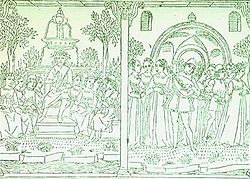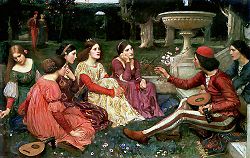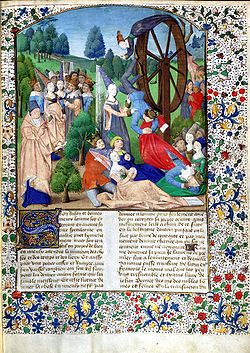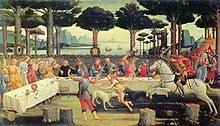- The Decameron
-
For other uses, see Decameron (disambiguation).
The Decameron 
Illustration from a ca. 1492 edition of Il Decameron published in VeniceAuthor(s) Giovanni Boccaccio Original title Il Decameron, cognominato Prencipe Galeotto Translator John Payne,
Richard Aldington,
James McMullen Rigg,
Mark Musa,
Peter Bondanella,
et al.Country Italy Language Italian Genre(s) Medieval allegory Publisher Filippo and Bernardo Giunti Published in
English1886 Media type Print OCLC Number 58887280 Dewey Decimal 853.1 LC Classification PQ4001-5999 The Decameron (Italian: Il Decameron, cognominato Prencipe Galeotto) is a 14th-century medieval allegory by Giovanni Boccaccio, told as a frame story encompassing 100 tales by ten young people.
Boccaccio probably began composing the work in 1350, and finished it in 1351 or 1353. The bawdy tales of love in The Decameron range from the erotic to the tragic. Tales of wit, practical jokes, and life lessons contribute to the mosaic. In addition to its literary import, it documents life in 14th-century Italy.
Contents
Title
The book's primary title exemplifies Boccaccio's fondness for Greek philology: Decameron combines two Greek words, Greek: δέκα déka ("ten") and (Greek: ἡμέρα hēméra ("day"), to form a term that means "ten-day event".[1] Ten days is the time period in which the characters of the frame story tell their tales.
Boccaccio's alternative title, Prencipe Galeotto (Prince Galehaut), refers to Galehaut, a fictional king portrayed in the Lancelot-Grail who was sometimes called by the title haut prince ("high prince"). Galehaut was a close friend of Lancelot and an enemy of King Arthur. When Galehaut learned that Lancelot loved Arthur's wife, Guinevere, he set aside his own ardor for the queen in order to arrange a tryst between his younger friend Lancelot and Guinevere. At this meeting the Queen first kisses Lancelot, and so begins their love affair.
In Canto V of Inferno, Dante compares these fictional lovers with the real-life paramours Francesca da Rimini and Paolo Malatesta, whose relationship he fictionalises. In Inferno, Francesca and Paolo read of Lancelot and Guinevere, and the story impassions them to lovemaking.
Dante's description of Galehaut's munificence and savoir-faire admidst this intrigue impressed Boccaccio. By invoking the name Prencipe Galeotto in the alternative title to Decameron, Boccaccio alludes to a sentiment he expresses in the text: his compassion for women deprived of free speech and social liberty, confined to their homes and, at times, lovesick. He contrasts this life with that of the menfolk, who enjoy respite in sport, such as hunting, fishing, riding, and falconry.[2]
Frame story
Further information: Summary of Decameron talesIn Italy during the time of the Black Death, a group of seven young women and three young men flee from plague-ridden Florence to a villa, where no one lives, in the countryside of Fiesole for two weeks. To pass the evenings, every member of the party tells a story each night for ten days, except for one day per week for chores, and the holy days in which they do no work at all. Thus, by the end of the fortnight they have told 100 stories.
 A Tale from the Decameron (1916) by John William Waterhouse.
A Tale from the Decameron (1916) by John William Waterhouse.
Each of the ten characters is charged as King or Queen of the company for one of the ten days in turn. This charge extends to choosing the theme of the stories for that day, and all but two days have topics assigned: examples of the power of fortune; examples of the power of human will; love tales that end tragically; love tales that end happily; clever replies that save the speaker; tricks that women play on men; tricks that people play on each other in general; examples of virtue. Only Dioneo, who usually tells the tenth tale each day, has the right to tell a tale on any topic he wishes, due to his wit.[3],[4]. Many authors have argued that Dioneo expresses the views of Boccaccio himself.[5] Each day also includes a short introduction and conclusion to continue the frame of the tales by describing other daily activities besides story-telling. These frame tale interludes frequently include transcriptions of Italian folk songs.[clarification needed (see talk)] The interactions among tales in a day, or across days, as Boccaccio spins variations and reversals of previous material, forms a whole and not just a collection of stories. The basic plots of the stories including mocking the lust and greed of the clergy; tensions in Italian society between the new wealthy commercial class and noble families; the perils and adventures of traveling merchants.
Analysis
 Lady Fortune (an aspect of Fortuna) spins her Rota Fortunae in the illustration on this recto (from a 1467 edition of Boccaccio's De Casibus Virorum Illustrium).
Lady Fortune (an aspect of Fortuna) spins her Rota Fortunae in the illustration on this recto (from a 1467 edition of Boccaccio's De Casibus Virorum Illustrium).
Throughout Decameron the mercantile ethic prevails and predominates. The commercial and urban values of quick wit, sophistication, and intelligence are treasured, while the vices of stupidity and dullness are cured, or punished. While these traits and values may seem obvious to the modern reader, they were an emerging feature in Europe with the rise of urban centers and a monetized economic system beyond the traditional rural feudal and monastery systems which placed greater value on piety and loyalty.
Beyond the unity provided by the frame narrative, Decameron provides a unity in philosophical outlook. Throughout runs the common medieval theme of Lady Fortune, and how quickly one can rise and fall through the external influences of the "Wheel of Fortune". Boccaccio had been educated in the tradition of Dante's Divine Comedy which used various levels of allegory to show the connections between the literal events of the story and the Christian message. However, Decameron uses Dante's model not to educate the reader but to satirize this method of learning. The Roman Catholic Church, priests, and religious belief become the satirical source of comedy throughout. This was part of a wider historical trend in the aftermath of the Black Death which saw widespread discontent with the church.
Many details of the Decameron are infused with a medieval sense of numerological and mystical significance. For example, it is widely believed that the seven young women are meant to represent the Four Cardinal Virtues (Prudence, Justice, Temperance, and Fortitude) and the Three Theological Virtues (Faith, Hope, and Charity). It is further supposed that the three men represent the classical Greek tripartite division of the soul (Reason, Spirit, and Appetite, see Book IV of Republic). Boccaccio himself notes that the names he gives for these ten characters are in fact pseudonyms chosen as "appropriate to the qualities of each". The Italian names of the seven women, in the same (most likely significant) order as given in the text, are: Pampinea, Fiammetta, Filomena, Emilia, Lauretta, Neifile, and Elissa. The men, in order, are: Panfilo, Filostrato, and Dioneo.
Boccaccio focused on the naturalness of sex by combining and interlacing sexual experiences with nature. By weaving them the way he does, Boccaccio permanently places sex into the world of nature by making it seem normal.
Literary sources
Boccaccio, in turn, borrowed the plots of almost all of his stories. Although he only consulted French, Italian, and Latin sources, some of the tales have their ultimate origin in such far-off lands as India, Persia, Spain, and other places. Moreover, some were already centuries old. For example, part of the tale of Andreuccio of Perugia (II, 5) originated in second century Ephesus (in the Ephesian Tale). The frame narrative structure (though not the characters or plot) originates from the Panchatantra, which was written in Sanskrit before 500 AD and came to Boccaccio through a chain of translations that includes Old Persian, Arabic, Hebrew, and Latin. Even the description of the central current event of the narrative, the Black Plague (which Boccaccio surely witnessed), is not original, but based on the Historia gentis Langobardorum of Paul the Deacon, who lived in the eighth century.
Some scholars have suggested that some of the tales for which there is no prior source may still have not have been invented by Boccaccio, but may have been circulating in the local oral tradition and Boccaccio may have been simply the first person known to record them. Boccaccio himself says that he heard some of the tales orally. In VII, 1, for example, he claims to have heard the tale from an old woman who heard it as a child.
 The Banquet in the Pine Forest (1482/3) is the third painting in Sandro Botticelli's series The Story of Nastagio degli Onesti, which illustrates events from the Eighth Story of the Fifth Day.
The Banquet in the Pine Forest (1482/3) is the third painting in Sandro Botticelli's series The Story of Nastagio degli Onesti, which illustrates events from the Eighth Story of the Fifth Day.
However, just because Boccaccio borrowed the storylines that make up most of the Decameron doesn't mean he mechanically reproduced them. Most of the stories take place in the 14th century and have been sufficiently updated for the author's time that a reader may not know that they had been written centuries earlier or in a foreign culture. Also, Boccaccio often combined two or more unrelated tales into one (such as in II, 2 and VII, 7).
Moreover, many of the characters actually existed, such as Giotto di Bondone, Guido Cavalcanti, Saladin and King William II of Sicily. Scholars have even been able to verify the existence of less famous characters, such as the tricksters Bruno and Buffalmacco and their victim Calandrino. Still other fictional characters are based on real people, such as the Madonna Fiordaliso from tale II, 5, who is derived from a Madonna Flora who lived in the red light district of Naples. Boccaccio often intentionally muddled historical (II, 3) and geographical (V, 2) facts for his narrative purposes. Within the tales of the Decameron, the principal characters are usually developed through their dialogue and actions, so that by the end of the story they seem real and their actions logical given their context.
Another of Boccaccio's frequent techniques was to make already existing tales more complex. A clear example of this is in tale IX, 6, which was also used by Chaucer in his "The Reeve's Tale", but more closely follows the original French source than does Boccaccio's version. In the Italian version, the host's wife (in addition to the two young male visitors) occupy all three beds and she also creates an explanation of the happenings of the evening. Both elements are Boccaccio's invention and make for a more complex version than either Chaucer's version or the French source (a fabliau by Jean de Boves).
Literary influence
The compelling way in which the tales were written and their almost exclusively Renaissance flair made the stories from the Decameron an irresistible source that many later writers borrowed from. Notable examples include:
- The famous first tale (I, 1) of the notorious Ser Ciappelletto was later translated into Latin by Olimpia Fulvia Morata and translated again by Voltaire.
- Martin Luther retells tale I, 2, in which a Jew converts to Catholicism after visiting Rome and seeing the corruption of the Catholic hierarchy. However, in Luther's version (found in his "Table-talk #1899"), Luther and Philipp Melanchthon try to dissuade the Jew from visiting Rome.
- Marguerite de Navarre, Heptaméron.
- The ring parable is at the heart of both Gotthold Ephraim Lessing's 1779 play Nathan the Wise and tale I, 3. In a letter to his brother on August 11, 1778, he says explicitly that he got the story from the Decameron. Jonathan Swift also used the same story for his first major published work, A Tale of a Tub.
- Posthumus's wager on Imogen's chastity in Cymbeline was taken by Shakespeare from an English translation of a fifteenth century German tale, "Frederyke of Jennen", whose basic plot came from tale II, 9.
- Both Molière and Lope de Vega use tale III, 3 to create plays in their respective vernaculars. Molière wrote L'école des maris in 1661 and Lope de Vega wrote Discreta enamorada.
- Tale III, 9, which Shakespeare converted into All's Well That Ends Well. Shakespeare probably first read a French translation of the tale in William Painter's Palace of Pleasure.
- Tale IV, 1 was reabsorbed into folklore to appear as Child ballad 269, Lady Diamond.[6]
- John Keats borrowed the tale of Lisabetta and her pot of basil (IV, 5) for his poem, Isabella, or the Pot of Basil.
- Lope de Vega also used parts of V, 4 for his play No son todos ruiseñores (They're Not All Nightingales).
- Christoph Martin Wieland's set of six novellas Das Hexameron von Rosenhain is based on the structure of the Decameron.
- The title character in George Eliot's historical novel Romola emulates Gostanza in tale V, 2, by buying a small boat and drifting out to sea to die, after she realizes that she no longer has anyone on whom she can depend.
- Tale V, 9 became the source for works by two famous nineteenth century writers in the English language. Henry Wadsworth Longfellow used it in his "The Falcon of Ser Federigo" as part of Tales of a Wayside Inn in 1863. Alfred, Lord Tennyson used it in 1879 for a play entitled The Falcon.
- Molière also borrowed from tale VII, 4 in his George Dandin, ou le Mari Confondu (The Confounded Husband). In both stories the husband is convinced that he has accidentally caused his wife's suicide.
- Giuseppe Petrosinelli in his libretto for Domenico Cimarosa's opera The Italian Girl in London uses the story of the heliotrope (bloodstone) in tale VIII, 3.
- The motif of the three trunks in The Merchant of Venice by Shakespeare is found in tale X, 1. However, both Shakespeare and Boccaccio probably came upon the tale in Gesta Romanorum.
- At his death Percy Bysshe Shelley had left a fragment of a poem entitled "Ginevra", which he took from the first volume of an Italian book called L'Osservatore Fiorentino. The earlier Italian text had a plot taken from tale X, 4.
- Tale X, 5 shares its plot with Chaucer's "The Franklin's Tale", although this is not due to a direct borrowing from Boccaccio. Rather, both authors used a common French source.
- The tale of patient Griselda (X, 10) was the source of Chaucer's "The Clerk's Tale." However, there are some scholars that believe Chaucer may not have been directly familiar with the Decameron, and instead derived it from a Latin translation/retelling of that tale by Petrarch.
- Christine de Pizan often restructures tales from Decameron in her work "The Book of the City of Ladies"
- Tzvetan Todorov used the Decameron as the basis for The Grammar of the Decameron (1969), an exploration of the general structure of all narrative.
- In the '60s, Hugh Hefner tried to adapt the bawdier stories from the Decameron into full-fledged pornography.
- The Charles Bukowski novel Women (1978) was inspired by The Decameron.
- Paul Calandrino's play The Nincompoop (2007) casts Calandrino in a new tale in which the simpleton is inspired to paint the ceiling of his local church while Bruno and Buffalmacco plot new ways to humiliate him.
- Steven James's mystery thriller novel The Knight (2009) depicts a serial killer who bases his murders off tales told in day four of The Decameron.
Film adaptations
A number of film adaptations have been based on tales from The Decameron. Pier Paolo Pasolini's Decameron (1971) is one of the most famous. Decameron Nights (1953) was based on three of the tales and starred Louis Jourdan as Boccaccio. Dino De Laurentiis produced a romantic comedy film version, Virgin Territory, in 2007.
Boccaccio's drawings
Since The Decameron was very popular among contemporaries, especially merchants, there is an enormous quantity of ancient manuscripts of it. The Italian philologist Vittore Branca did a comprehensive survey of them and identified a few copied under Boccaccio's supervision; some have notes written in Boccaccio's hand. Two in particular have elaborate drawings, probably done by Boccaccio himself. Since these manuscripts were widely circulated, Branca thought that they influenced all subsequent illustrations.
See also
References
- ^ The title transliterates to Greek as δεκάμερον (τό) or, classically, δεχήμερον.
- ^ Boccaccio, "Proem"
- ^ Lee Patterson Literary practice and social change in Britain, 1380-1530 p.186
- ^ Boccaccio, "Day the First"
- ^ The origin of the Griselda story p.7
- ^ Helen Child Sargent, ed; George Lyman Kittredge, ed English and Scottish Popular Ballads: Cambridge Edition p 583 Houghton Mifflin Company Boston 1904
External links
- Decameron Web, from Brown University
- The Decameron - Introduction, from the Internet Medieval Sourcebook
- 'The Enchanted Garden', a painting by John William Waterhouse
- The Decameron, Volume I at Project Gutenberg (Rigg translation)
- The Decameron, Volume II at Project Gutenberg (Rigg translation)
- The Decameron at Project Gutenberg (Payne translation)
- Concordances of Decameron
- Decameron English and Italian text for a direct comparison
- from Decameron - Federigo degli Alberighi (9th novel) on audio mp3- free download (in Italian & English)
- Complete italian .OGG recording - Creative Commons License
Works by Giovanni Boccaccio Corbaccio · De Casibus Virorum Illustrium · De mulieribus claris · The Decameron · Elegia di Madonna Fiammetta · The Filocolo · Il Filostrato · Genealogia Deorum Gentilium · TeseidaCategories:- 14th-century books
- 1353 books
- Italian novels
- Culture in Florence
- Medieval Italian literature
- Works by Giovanni Boccaccio
Wikimedia Foundation. 2010.
